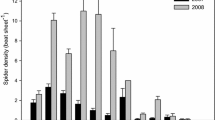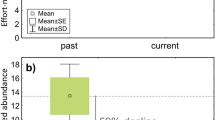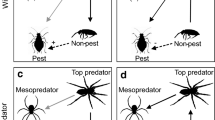Abstract
The relationship between environmental variables (chiefly temperature and humidity) and the population dynamics of spider mites is reviewed. Both direct effects on the spider mites and indirect effects operating through effects on spider mite natural enemies (mainly phytoseiid mites) are discussed. Factors determining the environmental conditions actually experienced by spider mites (microenvironment) are presented.
Microenvironmental information versus environmental information from nearby weather stations is evaluated for utility in predicting spider mite population dynamics. A comprehensive plant canopy/spider mite/phytoseiid model is used to simulate an irrigated maize/spider-mite/phytoseiid system in a semi-arid climate. Under nearly all tested combinations of weather and irrigation, substantial differences were seen between simulations that considered microenvironment and those that considered only environmental conditions above the plant canopy. Future research needs are discussed.
Similar content being viewed by others
References
Allawi, T.F., 1983. Biological studies ofNeoseiulus fallacis feeding onTetranychus urticae andOligonychus pratensis. Ph.D. Dissertation, Department of Zoology/Entomology, Colorado State University, Fort Collins, Colo., 108 pp.
Badii, M.H. and McMurtry, J.A., 1984. Life history of and life table parameters forPhytoseiulus longipes with comparative studies onP. persimilis andTyphlodromus occidentalis (Acari: Phytoseiidae). Acarologia, 25: 111–123.
Barcelo, J.A., 1981. Photoeffects of visible and ultraviolet radiation on the two-spotted spider mite.Tetranychus urticae. Photochem. Photobiol., 33: 703–706.
Berry, J.S., Holtzer, T.O., Innis, G.S. and Logan, J.A., 1988. A simple order-of-preference technique for modeling the predator functional response in an acarine predator/prey system. Exp. Appl. Acarol., 5: (in press)
Boyne, J.V. and Hain, F.P., 1983. Responses ofNeoseiulus fallacis (Acarina: Phytoseiidae) to different prey densities ofOligonychus ununguis (Acarina: Tetranychidae), and to different relative humidity regimes. Can. Entomol., 115: 1607–1614.
Congdon, B.D. and Logan, J.A., 1983. Temperature effects on development and fecundity ofOligonychus pratensis (Acari: Tetranychidae). Environ. Entomol., 12: 359–362.
Crooker, A., 1985. Embryonic and juvenile development. In: W. Helle and M.W. Sabelis (Editors), Spider Mites, Their Biology, Natural Enemies and Control. Vol. 1A. Elsevier, Amsterdam, pp. 149–163.
Curry, G.L., Feldman, R.M. and Sharpe, P.J.H. 1978a. Foundations of stochastic development. J. Theor. Biol., 74: 397–410.
Curry, G.L., Feldman, R.M. and Smith, K.C., 1978b. A stochastic model of a temperature-dependent population. J. Theor. Popul. Biol., 13: 197–213.
De Moraes, G.J. and McMurtry, J.A., 1981. Biology ofAmblyseius citrifolius (Denmark and Muma) (Acarina: Phytoseiidae). Hilgardia, 49: 1–29.
Ferro, D.N. and Chapman, R.B., 1979. Effects of different constant humidities and temperatures on twospotted spider mite egg hatch. Environ. Entomol., 8: 701–705.
Ferro, D.N. and Southwick, E.E., 1984. Microclimates of small arthropods: estimating humidity within the leaf boundary layer. Environ. Entomol., 13: 926–929.
Ferro, D.N., Chapman, R.B. and Penman, D.R., 1979. Observations on insect microclimate and insect pest management. Environ. Entomol., 8: 1000–1003.
Gardner, W.A., Oetting, R.D. and Storey, G.K., 1982. Susceptibility of the two-spotted spider mite,Tetranychus urticae Koch, to the fungal pathogenHirsutella thompsonii Fisher. Fla. Entomol., 65: 458–465.
Gerson, U., Kenneth, R. and Muttath, T.I., 1979.Hirsutella thompsonii, a fungal pathogen of mites. II. Host-pathogen interactions. Ann. Appl. Biol., 91: 29–40.
Hazan, A., Gerson, U. and Tahori, A.S., 1973. Life history and life tables of the carmine spider mite. Acarologia, 15: 414–440.
Hazan, A., Gerson, U. and Tahori, A.S., 1974. Spider mite webbing. I. The production of webbing under various environmental conditions. Acarologia, 16: 68–84.
Kennedy, G.G. and Smitley, D.R., 1985. Dispersal. In: W. Helle and M.W. Sabelis (Editors), Spider Mites, Their Biology. Natural Enemies and Control. Vol. 1A. Elsevier, Amsterdam, pp. 233–242.
Logan, J.A., 1988. Toward an expert system for development of pest simulation models. Environ. Entomol. (in press).
Logan, J.A., Wollkind, D.J., Hoyt, S.C. and Tanigoshi, L.K., 1976. An analytical model for description of temperature dependent rate phenomena in arthropods. Environ. Entomol., 5: 1133–1140.
McMurtry, J.A. and Scriven, G.T., 1965. Life history studies ofAmblyseius limonicus, with comparative studies onAmblyseius hibisci (Acarina: Phytoseiidae). Ann. Entomol. Soc. Am., 58: 106–111.
McMurtry, J.A., Mahr, D.L. and Johnson, H.G., 1976. Geographic races in the predaceous mite,Amblyseius potentillae (Acari: Phytoseiidae). Int. J. Acarol., 2: 23–28.
Monteith, J.L. and Butler, D.R., 1979. Dew and thermal lag: A model for cocoa pods. Q. J. R. Meteorol. Soc., 105: 207–215.
Nobel, P.S., 1983. Biophysical Plant Physiology and Ecology. Freeman, San Francisco, 608 pp.
Norman, J.M., 1979. Modeling the complete crop canopy. In: B. Barfield and J. Geiber (Editors), Modification of the Aerial Environment of Crops. American Society of Agricultural Engineers, St. Joseph, Mich.,Asae Monogr. No. 2, pp. 249–277.
Norman, J.M., 1982. Simulation of microclimates. In: J.L. Hatfield and I.J. Thomason (Editors), Biometeorology in Integrated Pest Management. Academic Press, London, pp. 65–99.
Norman, J.M. and Campbell, G.S., 1983. Application of a plant-environment model to problems in irrigation. In: D. Hill (Editor), Advances in Irrigation. Academic Press, London, pp. 155–188.
Norman, J.M., Toole, J.L., Holtzer, T.O. and Perring, T.M., 1984. Energy budget for the Banks grass mite (Acari: Tetranychidae) and its use in deriving mite body temperatures. Environ. Entomol., 13: 344–347.
Perring, T.M., Holtzer, T.O., Kalisch, J.A. and Norman, J.M., 1984a. Temperature and humidity effects on ovipositional rates, fecundity, and longevity of adult female Banks grass mites Acari: Tetranychidae). Ann. Entomol. Soc. Am., 77: 581–586.
Perring, T.M., Holtzer, T.O., Toole, J.L., Norman, J.M. and Myers, G.L., 1984b. Influences of temperature and humidity on pre-adult development of the Banks grass mite, (Acari: Tetranychidae). Environ. Entomol., 13: 338–343.
Putman, W.L., 1970. Effects of water and high humidity on the European red mite,Panonychus ulmi (Acarina: Tetranychidae). Can. Entomol., 102: 955–961.
Rabbinge, R., 1976. Biological control of fruit-tree red spider mite.Pudoc (Centre for Agricultural Publishing and Documentation), Wageningen, 228 pp.
Rosenberg, N.J., Blad, B.L. and Verma, S.B., 1983. Microclimate, The Biological Environment (2nd edition). Wiley Interscience, New York, 495 pp.
Sabelis, M.W., 1981. Biological control of two-spotted spider mites using phytoseiid predators. Part I. Modelling the predator-prey interaction at the individual level.Pudoc (Centre for Agricultural Publishing and Documentation), Wageningen, 242 pp.
Sabelis, M.W., 1985. Development. In: W. Helle and M.W. Sabelis (Editors), Spider Mites, Their Biology, Natural Enemies and Control. Vol. 1B. Elsevier, Amsterdam, pp. 43–53.
Shaffer, P.L., 1983. Prediction of variation in development period of insects and mites reared at constant temperatures. Environ. Entomol., 12: 1012–1019.
Sharpe, P.J.H., Curry, G.L., DeMichele, D.W. and Cole, C.L., 1977. Distribution model of organism development times. J. Theor. Biol., 66: 21–38.
Sharpe, P.J.H., Schoolfield, R.M. and Butler, G.D., Jr., 1981. Distribution model ofHeliothis zea (Lepidoptera: Noctuidae) development times. Can. Entomol., 113: 845–856.
Smitley, D.R., Brooks, W.M. and Kennedy, G.G., 1986a. Environmental effects on production of primary and secondary conidia, infection, and pathogenesis ofNeozygites floridana, a pathogen of the two-spotted spider mite,Tetranychus urticae. J. Invertebr. Pathol., 47: 325–332.
Smitley, D.R., Kennedy, G.G. and Brooks, W.M., 1986b. Role of the entomogenous fungus,Neozygites floridana, in population declines of the two-spotted spider mite,Tetranychus urticae, on field corn. Entomol. Exp. Appl., 41: 255–264.
Southwood, T.R.E., 1978. Ecological Methods. Chapman and Hall, London, 524 pp.
Stenseth, C., 1979. Effect of temperature and humidity on the development ofPhytoseiulus persimilis and its ability to regulate populations ofTetranychus urticae (Acarina: Phytoseiidae, Tetranychidae). Entomophaga, 24: 311–317.
Tanigoshi, L.K., Hoyt, S.C., Browne, R.W. and Logan, J.A., 1975a. Influence of temperature on population increase ofTetranychus mcdanieli (Acarina: Tetranychidae). Ann. Entomol. Soc. Am., 68: 972–978.
Tanigoshi, L.K., Hoyt, S.C., Browne, R.W. and Logan, J.A., 1975b. Influence of temperature on population increase ofMetaseiulus occidentalis (Acarina: Phytoseiidae). Ann. Entomol. Soc. Am., 68: 979–986.
Tanigoshi, L.K., Fargerlund, J. and Nishio-Wong, J.Y., 1981. Significance of temperature and food resources to the developmental biology ofAmblyseius hibisci (Chant) (Acarina: Phytoseiidae). Z. Angew. Entomol., 92: 409–419.
Toole, J.L., Norman, J.M., Holtzer, T.O. and Perring, T.M., 1984. Simulating Banks grass mite (Acari: Tetranychidae) population dynamics as a subsystem of a crop canopy-microenvironment model. Environ. Entomol., 13: 329–337.
Tulisalo, U., 1974. Control of the two-spotted spider mite (Tetranychus urticae Koch) by high air humidity or direct contact with water. Ann. Entomol. Fenn., 40: 158–162.
Van der Geest, L.P.S., 1985. Pathogens of spider mites. In: W. Helle and M.W. Sabelis (Editors), Spider Mites, Their Biology, Natural Enemies and Control, Vol. 1B. Elsevier, Amsterdam, pp. 247–258.
Van Dinh, N., Sabelis, M.W. and A. Janssen, 1988. Influence of humidity and water availability on the survival ofAmblyseius idaeus andAmblyseius anonymus (Acarina: Phytoseiidae). Exp. Appl. Acarol., 4: 27–40.
Wagner, T.L., Wu, H., Sharpe, P.J.H. and Coulson, R.N., 1984a. Modeling distributions of insect development times: A literature review and application of the Weibull function. Ann. Entomol. Soc. Am., 77: 475–487.
Wagner, T.L., Wu, H., Sharpe, P.J.H., Schoolfield, R.M. and Coulson, R.N., 1984b. Modeling insect development rates: A literature review and application of a biophysical model. Ann. Entomol. Soc. Am., 77: 208–225.
Wrensch, D.L., 1985. Reproductive Parameters. In: W. Helle and M.W. Sabelis (Editors), Spider Mites, Their Biology, Natural Enemies and Control, Vol. 1A. Elsevier, Amsterdam, pp. 165–170.
Yaninek, J.S. and Animashaun, A., 1987. Why cassava green mites are dry-season pests. In: D. Rijks and J. Mathys (Editors), Proc. Seminar on Agrometeorology and Crop Protection in the Lowland Humid and Subhumid Tropics, Cotonou, Benin, 7–11 July 1986. World Meteorological Organization, Geneva, pp. 59–68.
Author information
Authors and Affiliations
Rights and permissions
About this article
Cite this article
Holtzer, T.O., Norman, J.M., Perring, T.M. et al. Effects of microenvironment on the dynamics of spider-mite populations. Exp Appl Acarol 4, 247–264 (1988). https://doi.org/10.1007/BF01196189
Accepted:
Issue Date:
DOI: https://doi.org/10.1007/BF01196189




